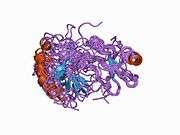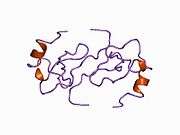CCL3L1
| CCL3L1 |
|---|
 |
| Identifiers |
|---|
| Aliases | CCL3L1, 464.2, D17S1718, G0S19-2, LD78, LD78-beta(1-70), LD78BETA, MIP1AP, SCYA3L, SCYA3L1, C-C motif chemokine ligand 3 like 1 |
|---|
| External IDs | GeneCards: CCL3L1 |
|---|
|
| Orthologs |
|---|
| Species | Human | Mouse |
|---|
| Entrez | | |
|---|
| Ensembl | | |
|---|
| UniProt | | |
|---|
| RefSeq (mRNA) | | |
|---|
| RefSeq (protein) | | |
|---|
| Location (UCSC) | n/a | n/a |
|---|
| PubMed search | [1] | n/a |
|---|
| Wikidata |
|
Chemokine (C-C motif) ligand 3-like 1, also known as CCL3L1, is a protein which in humans is encoded by the CCL3L1 gene.[2][3][4]
Function
This gene is one of several chemokine genes clustered on the q-arm of chromosome 17. Chemokines are a family of secreted proteins involved in immunoregulatory and inflammatory processes. Specifically, chemokines attract lymphocytes to sites of infection or damage. This protein binds to several chemokine receptors including chemokine binding protein 2 (CCBP2 or D6) and chemokine (C-C motif) receptor 5 (CCR5).
CCR5 is a co-receptor for HIV, and binding of CCL3L1 to CCR5 inhibits HIV entry. Furthermore, the binding causes the receptor to be taken inside the cell by endocytosis, to eventually be reprocessed and re-expressed.[2]
Gene organization
The human genome reference assembly contains two full copies of the gene (CCL3L1 and CCL3L3) and an additional partial duplication, which is thought to result in a pseudogene, designated CCL3L2. This record represents the more telomeric full-length gene.[2]
Clinical significance
The copy number of this gene varies among individuals. This is hypothesized to be due to segmental duplication of the region containing CCL3. Most individuals have 1-6 copies in the diploid genome, although rare individuals have zero or more than six copies. With increased copy number, there is more CCL3L1 expressed, and so competition for the CCR5 binding site is increased. This leads to slower advancement of disease in HIV-infected individuals, giving those with greater copy number more resistance.[2]
Interactions
CCL3L1 has been shown to interact with CCR5.[5][6]
References
- ↑ "Human PubMed Reference:".
- 1 2 3 4 "Entrez Gene: CCL3L1 chemokine (C-C motif) ligand 3-like 1".
- ↑ Irving SG, Zipfel PF, Balke J, McBride OW, Morton CC, Burd PR, Siebenlist U, Kelly K (Jun 1990). "Two inflammatory mediator cytokine genes are closely linked and variably amplified on chromosome 17q". Nucleic Acids Research. 18 (11): 3261–70. PMC 330932
 . PMID 1972563. doi:10.1093/nar/18.11.3261.
. PMID 1972563. doi:10.1093/nar/18.11.3261. - ↑ Hirashima M, Ono T, Nakao M, Nishi H, Kimura A, Nomiyama H, Hamada F, Yoshida MC, Shimada K (1992). "Nucleotide sequence of the third cytokine LD78 gene and mapping of all three LD78 gene loci to human chromosome 17". DNA Sequence : The Journal of DNA Sequencing and Mapping. 3 (4): 203–12. PMID 1296815. doi:10.3109/10425179209034019.
- ↑ Miyakawa T, Obaru K, Maeda K, Harada S, Mitsuya H (Feb 2002). "Identification of amino acid residues critical for LD78beta, a variant of human macrophage inflammatory protein-1alpha, binding to CCR5 and inhibition of R5 human immunodeficiency virus type 1 replication". The Journal of Biological Chemistry. 277 (7): 4649–55. PMID 11734558. doi:10.1074/jbc.M109198200.
- ↑ Struyf S, Menten P, Lenaerts JP, Put W, D'Haese A, De Clercq E, Schols D, Proost P, Van Damme J (Jul 2001). "Diverging binding capacities of natural LD78beta isoforms of macrophage inflammatory protein-1alpha to the CC chemokine receptors 1, 3 and 5 affect their anti-HIV-1 activity and chemotactic potencies for neutrophils and eosinophils". European Journal of Immunology. 31 (7): 2170–8. PMID 11449371. doi:10.1002/1521-4141(200107)31:7<2170::AID-IMMU2170>3.0.CO;2-D.
External links
Further reading
- Hirashima M, Ono T, Nakao M, Nishi H, Kimura A, Nomiyama H, Hamada F, Yoshida MC, Shimada K (1993). "Nucleotide sequence of the third cytokine LD78 gene and mapping of all three LD78 gene loci to human chromosome 17". DNA Sequence : The Journal of DNA Sequencing and Mapping. 3 (4): 203–12. PMID 1296815. doi:10.3109/10425179209034019.
- Nakao M, Nomiyama H, Shimada K (Jul 1990). "Structures of human genes coding for cytokine LD78 and their expression". Molecular and Cellular Biology. 10 (7): 3646–58. PMC 360801
 . PMID 1694014.
. PMID 1694014.
- Irving SG, Zipfel PF, Balke J, McBride OW, Morton CC, Burd PR, Siebenlist U, Kelly K (Jun 1990). "Two inflammatory mediator cytokine genes are closely linked and variably amplified on chromosome 17q". Nucleic Acids Research. 18 (11): 3261–70. PMC 330932
 . PMID 1972563. doi:10.1093/nar/18.11.3261.
. PMID 1972563. doi:10.1093/nar/18.11.3261.
- Blum S, Forsdyke RE, Forsdyke DR (Oct 1990). "Three human homologs of a murine gene encoding an inhibitor of stem cell proliferation". DNA and Cell Biology. 9 (8): 589–602. PMID 2271120. doi:10.1089/dna.1990.9.589.
- Adams MD, Kerlavage AR, Fleischmann RD, Fuldner RA, Bult CJ, Lee NH, Kirkness EF, Weinstock KG, Gocayne JD, White O (Sep 1995). "Initial assessment of human gene diversity and expression patterns based upon 83 million nucleotides of cDNA sequence" (PDF). Nature. 377 (6547 Suppl): 3–174. PMID 7566098.
- Naruse K, Ueno M, Satoh T, Nomiyama H, Tei H, Takeda M, Ledbetter DH, Coillie EV, Opdenakker G, Gunge N, Sakaki Y, Iio M, Miura R (Jun 1996). "A YAC contig of the human CC chemokine genes clustered on chromosome 17q11.2". Genomics. 34 (2): 236–40. PMID 8661057. doi:10.1006/geno.1996.0274.
- Nibbs RJ, Yang J, Landau NR, Mao JH, Graham GJ (Jun 1999). "LD78beta, a non-allelic variant of human MIP-1alpha (LD78alpha), has enhanced receptor interactions and potent HIV suppressive activity". The Journal of Biological Chemistry. 274 (25): 17478–83. PMID 10364178. doi:10.1074/jbc.274.25.17478.
- Xin X, Shioda T, Kato A, Liu H, Sakai Y, Nagai Y (Aug 1999). "Enhanced anti-HIV-1 activity of CC-chemokine LD78beta, a non-allelic variant of MIP-1alpha/LD78alpha". FEBS Letters. 457 (2): 219–22. PMID 10471782. doi:10.1016/S0014-5793(99)01035-2.
- Proost P, Menten P, Struyf S, Schutyser E, De Meester I, Van Damme J (Sep 2000). "Cleavage by CD26/dipeptidyl peptidase IV converts the chemokine LD78beta into a most efficient monocyte attractant and CCR1 agonist". Blood. 96 (5): 1674–80. PMID 10961862.
- Lambeir AM, Proost P, Durinx C, Bal G, Senten K, Augustyns K, Scharpé S, Van Damme J, De Meester I (Aug 2001). "Kinetic investigation of chemokine truncation by CD26/dipeptidyl peptidase IV reveals a striking selectivity within the chemokine family". The Journal of Biological Chemistry. 276 (32): 29839–45. PMID 11390394. doi:10.1074/jbc.M103106200.
- Struyf S, Menten P, Lenaerts JP, Put W, D'Haese A, De Clercq E, Schols D, Proost P, Van Damme J (Jul 2001). "Diverging binding capacities of natural LD78beta isoforms of macrophage inflammatory protein-1alpha to the CC chemokine receptors 1, 3 and 5 affect their anti-HIV-1 activity and chemotactic potencies for neutrophils and eosinophils". European Journal of Immunology. 31 (7): 2170–8. PMID 11449371. doi:10.1002/1521-4141(200107)31:7<2170::AID-IMMU2170>3.0.CO;2-D.
- Miyakawa T, Obaru K, Maeda K, Harada S, Mitsuya H (Feb 2002). "Identification of amino acid residues critical for LD78beta, a variant of human macrophage inflammatory protein-1alpha, binding to CCR5 and inhibition of R5 human immunodeficiency virus type 1 replication". The Journal of Biological Chemistry. 277 (7): 4649–55. PMID 11734558. doi:10.1074/jbc.M109198200.
- Townson JR, Barcellos LF, Nibbs RJ (Oct 2002). "Gene copy number regulates the production of the human chemokine CCL3-L1". European Journal of Immunology. 32 (10): 3016–26. PMID 12355456. doi:10.1002/1521-4141(2002010)32:10<3016::AID-IMMU3016>3.0.CO;2-D.
- Modi WS (Apr 2004). "CCL3L1 and CCL4L1 chemokine genes are located in a segmental duplication at chromosome 17q12". Genomics. 83 (4): 735–8. PMID 15028295. doi:10.1016/j.ygeno.2003.09.019.
- Zhang Z, Henzel WJ (Oct 2004). "Signal peptide prediction based on analysis of experimentally verified cleavage sites". Protein Science : A Publication of the Protein Society. 13 (10): 2819–24. PMC 2286551
 . PMID 15340161. doi:10.1110/ps.04682504.
. PMID 15340161. doi:10.1110/ps.04682504.
- Gonzalez E, Kulkarni H, Bolivar H, Mangano A, Sanchez R, Catano G, Nibbs RJ, Freedman BI, Quinones MP, Bamshad MJ, Murthy KK, Rovin BH, Bradley W, Clark RA, Anderson SA, O'connell RJ, Agan BK, Ahuja SS, Bologna R, Sen L, Dolan MJ, Ahuja SK (Mar 2005). "The influence of CCL3L1 gene-containing segmental duplications on HIV-1/AIDS susceptibility". Science. 307 (5714): 1434–40. PMID 15637236. doi:10.1126/science.1101160.
- Ryu OH, Choi SJ, Firatli E, Choi SW, Hart PS, Shen RF, Wang G, Wu WW, Hart TC (Apr 2005). "Proteolysis of macrophage inflammatory protein-1alpha isoforms LD78beta and LD78alpha by neutrophil-derived serine proteases". The Journal of Biological Chemistry. 280 (17): 17415–21. PMID 15728180. doi:10.1074/jbc.M500340200.
- Burns JC, Shimizu C, Gonzalez E, Kulkarni H, Patel S, Shike H, Sundel RS, Newburger JW, Ahuja SK (Jul 2005). "Genetic variations in the receptor-ligand pair CCR5 and CCL3L1 are important determinants of susceptibility to Kawasaki disease". The Journal of Infectious Diseases. 192 (2): 344–9. PMC 2894631
 . PMID 15962231. doi:10.1086/430953.
. PMID 15962231. doi:10.1086/430953.
PDB gallery |
|---|
| 1b50: NMR STRUCTURE OF HUMAN MIP-1A D26A, 10 STRUCTURES |
| 1b53: NMR STRUCTURE OF HUMAN MIP-1A D26A, MINIMIZED AVERAGE STRUCTURE |
|
|

 . PMID 1972563. doi:10.1093/nar/18.11.3261.
. PMID 1972563. doi:10.1093/nar/18.11.3261. . PMID 1694014.
. PMID 1694014. . PMID 1972563. doi:10.1093/nar/18.11.3261.
. PMID 1972563. doi:10.1093/nar/18.11.3261. . PMID 15340161. doi:10.1110/ps.04682504. Check date values in:
. PMID 15340161. doi:10.1110/ps.04682504. Check date values in:  . PMID 15962231. doi:10.1086/430953.
. PMID 15962231. doi:10.1086/430953.
